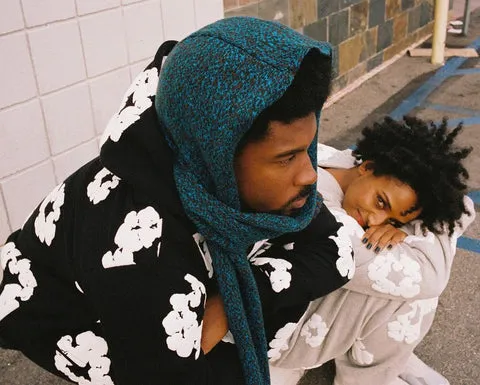Denim Tears Where American Art Meets Cultural Memory
Denim Tears was born from Tremaine Emory’s desire to bridge history, culture, and identity through fashion. As an artist and designer, Emory uses denim as a medium to tell stories that American history often leaves untold. The brand emerged not merely as a clothing line but as a canvas for reflection—where each stitch represents memory, resilience, and resistance. Denim Tears clothing’ creations celebrate the African American experience, weaving together threads of pain and pride, creativity and culture, to remind the world that art and fashion can be instruments of social awakening.
The Artistic Vision Behind the Brand
Tremaine Emory envisions Denim Tears as a living museum of Black history expressed through American fashion. Every collection functions as both artwork and narrative, conveying the emotional weight of generations. The brand’s visual language—cotton wreaths, vintage silhouettes, and symbolic prints—draws inspiration from cultural memory and shared struggle. Emory’s designs push beyond surface-level aesthetics, questioning what fashion should represent in society. Through this artistic lens, Denim Tears transforms ordinary denim into a storytelling device that speaks truth to history while honoring the people whose labor shaped America’s material culture.
Reimagining American Identity
Denim Tears challenges conventional ideas of what it means to be American by centering narratives that have long been marginalized. The brand uses fashion to reconstruct national identity from the perspective of the oppressed rather than the oppressor. Its designs highlight the complexities of heritage and the intersections of Blackness, creativity, and endurance. By reclaiming symbols of labor like cotton and denim, Emory redefines them as emblems of empowerment rather than exploitation. Denim Tears invites reflection on how collective identity can evolve when truth is embraced and history is faced without denial or distortion.
The Power of Cotton as a Symbol
Cotton is one of Denim Tears’ most powerful symbols, representing both trauma and triumph. Historically, cotton was the foundation of America’s economy, built on the forced labor of enslaved Africans. Emory transforms this painful legacy into a tool of artistic liberation. His signature cotton wreath design, printed on denim and sweatshirts, serves as a memorial to those who suffered while also celebrating their enduring strength. In this transformation, cotton becomes a bridge between the past and present—a reminder that beauty and meaning can emerge from even the harshest chapters of human history.
Fashion as Historical Storytelling
Through Denim Tears, fashion becomes an act of storytelling rather than simple self-expression. Each piece communicates layers of cultural memory, urging wearers to think critically about where their clothes come from and what they represent. Emory’s approach blurs the boundaries between apparel and art installation, turning garments into historical texts that can be worn and witnessed. By embedding truth into design, Denim Tears reminds the fashion industry that creativity carries responsibility. Every collection challenges consumers to engage with the social and historical narratives woven into fabric, reshaping how clothing reflects cultural consciousness.
Collaboration and Cultural Dialogue
Collaboration plays a vital role in Denim Tears’ creative evolution. Emory has partnered with influential brands like Levi’s, Converse, and Dior to bring his vision to wider audiences. Yet, even within these partnerships, the core message remains intact—Black culture and history are not to be diluted but celebrated. These collaborations foster dialogue between mainstream fashion and marginalized heritage, encouraging industries to embrace inclusivity and accountability. By merging commercial appeal with cultural storytelling, Denim Tears transforms collaboration into conversation, proving that art and activism can coexist within the fabric of popular culture.
The Role of Memory in Design
Memory serves as both muse and method in Denim Tears’ creative process. Emory’s work is rooted in personal and collective remembrance—of ancestors, of struggle, and of the resilience that defines the African American spirit. His designs act as monuments, ensuring that cultural memories are neither forgotten nor commercialized without meaning. Every collection captures the essence of lived experiences, transforming memory into motion through fabric. In doing so, Denim Tears helps preserve history in a tactile form, where wearing a piece of clothing becomes an act of remembrance and reverence for the past.
The Emotional Language of Denim
Denim is central to American culture, often symbolizing freedom, work, and rebellion. Emory reinterprets this material to communicate emotional truths about identity and injustice. For him, denim is not just fabric—it is the canvas of American life, carrying stories of survival and transformation. By recontextualizing denim, he gives it new emotional depth, turning everyday garments into expressions of remembrance. The raw texture, durability, and timelessness of denim mirror the endurance of Black communities throughout history. Denim Tears thus becomes a language of emotion, translating pain and pride into wearable art and cultural expression.
Impact on Contemporary Fashion
Denim Tears has reshaped how the fashion world approaches storytelling, authenticity, and representation. The brand’s impact reaches beyond aesthetics into education and activism, challenging other designers to confront the historical narratives behind their work. Emory’s influence has helped shift fashion toward greater social awareness, blending creativity with cultural integrity. Through his bold vision, Denim Tears has inspired a generation of artists and consumers to see clothing as a medium for truth. Its impact proves that fashion can be both beautiful and revolutionary, holding space for dialogue, dignity, and change.
A Legacy of Art and Memory
Denim Tears stands as a testament to the power of art to remember, heal, and transform. Tremaine Emory’s work ensures that the struggles and stories of African Americans remain embedded within America’s Denim Tears Hoodie cultural consciousness. The brand transcends trends, existing instead as a living archive—a reminder that history must be worn, not forgotten. Through the fusion of artistry and activism, Denim Tears redefines what it means to honor one’s roots while shaping the future. It is where American art meets cultural memory, proving that fashion can be both remembrance and revolution.







